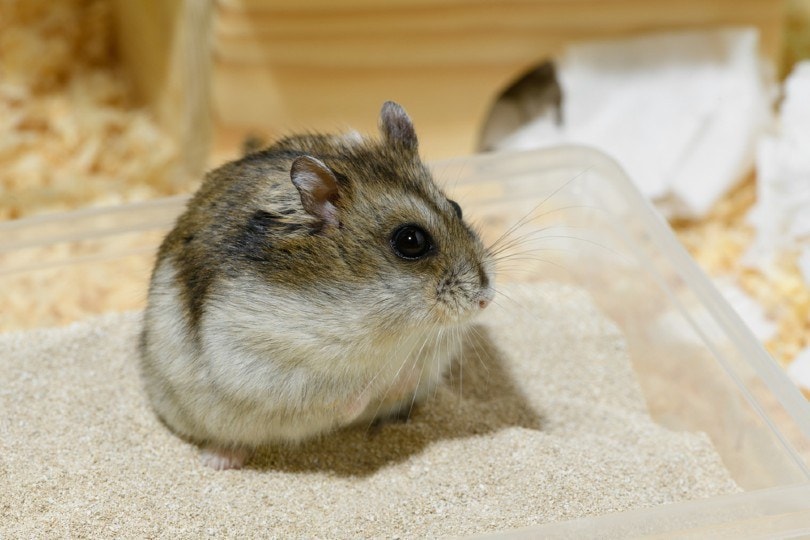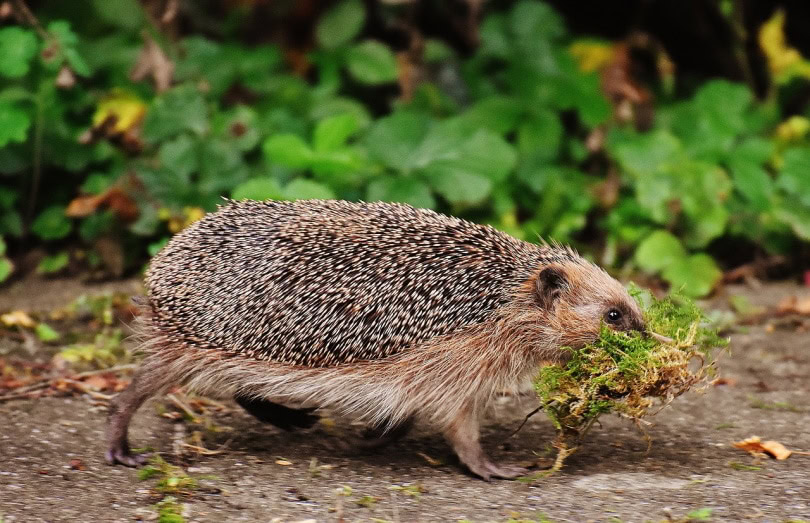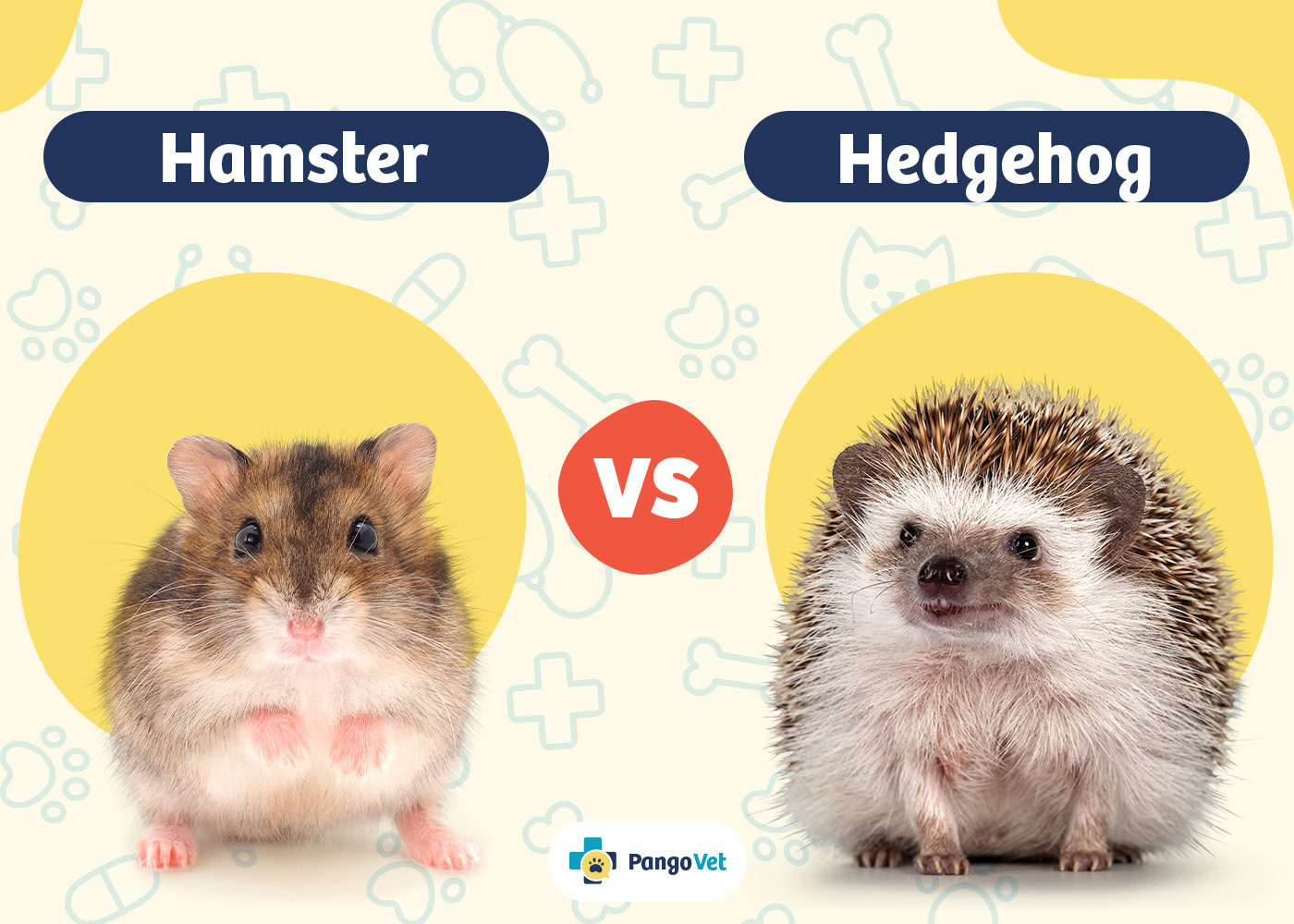VET APPROVED

The information is current and up-to-date in accordance with the latest veterinarian research.
Learn more »Click to Skip Ahead
Dogs and cats are the planet’s most popular companions, but small animals like hamsters and hedgehogs also make excellent pets. Unlike active breeds of canines and felines that require a great deal of space, small pets can live in practically any home with a suitable enclosure. Hamsters and hedgehogs are ideal for pet owners who prefer quiet animals, with less intensive exercise and maintenance needs.
Both creatures have relatively short lifespans, but they enjoy interacting with human caretakers when they’re introduced to them shortly after birth. Although they have similarities, the hamster and hedgehog are not related to each other.
Hamsters are related to rodents (mice, rats) in the Rodentia order, and hedgehogs are close relatives of shrews and moles in the Eulipotyphla order. Whether you’re looking for a small pet suitable for your space or you feel unsure about what species to bring to your family, we’ll examine the characteristics of each creature to assist your decision-making process.

Visual Differences

At a Glance
- Origin: Syria(Syrian hamster); China, Mongolia, and Russia (dwarf species)
- Size: 2-6 inches long
- Lifespan: 1.5-3 years
- Domesticated: Yes
- Origin: Central Africa (African pygmy hedgehog)
- Size: 6–8 inches long
- Lifespan: Up to 3-7 years
- Domesticated: Not completely domesticated, but are typically bred in human care

Hamster Overview

Although hamsters are standard fixtures of school classrooms and children’s bedrooms, the mammal was not available as a pet in North America until the 1940s. In 1930, the biologist Israel Aharoni traveled to Syria to find a rare Golden rodent that previous explorers had mentioned.
After taking a colony of 11 Syrian hamsters back to his lab in Jeruselum, Aharoni was surprised when two of the hamsters mated, and their offspring became the foundation of the pet hamster industry.
Characteristics & Appearance
Although some types of hamsters can be aggressive and unsuitable as pets, the golden hamster, also known as the Syrian hamster, is a docile creature that acts tame around humans. They usually do not grow more than 6 inches long, and their light-brown coat fades to white or grey on their undersides. They have large ears, a short tail, a blunt snout, and small eyes.
Hamsters are nocturnal mammals that are most active at night. When they’re kept as pets, they often spend several hours running on their exercise wheels. During the day, pet hamsters sleep most of the time, but they often wake up to run on the wheel for a few minutes or drink from the water bottle.

Hamsters rarely live more than 2 or 3 years, but the rodent’s short lifespan contrasts its impressive fertility rates. Females can birth two to three liters in their lifetimes with four to 10 babies per litter, although some can have up to 12.
Reproductive performance in females decreases with age. However, healthy females can remain fertile for 12–14 months or longer. Breeding after 12 months is generally not recommended due to potential increases in health risks.
Their offspring can quickly become sexually active, sometimes as young as 4 weeks old. This is an adaptive mechanism that allows this prey species to quickly replenish their numbers when heavily preyed on by hawks, snakes, and other predators in the wild.
Syrian females have brief gestation periods lasting 16 days, other species have slightly larger gestation periods of 18-22 days. While they can give birth to large litters, not all pups survive. Neonatal mortality can result from factors like poor maternal care, environmental stress, nutritional deficiencies, or overcrowding. First-time mothers or those disturbed during or shortly after giving birth may also cannibalize their young, especially if they sense illness or weakness in the pups. Ensuring a quiet, safe, and well-nourished environment is key to improving survival rates.
Lastly, not all hamster species are social, Syrian hamsters are solitary and territorial. Because of this behavior, pet parents planning on giving their children a hamster couple may want to consider only getting one as a pet.

Uses
Hamsters are popular pets, but they’re also used extensively in laboratory experiments. They’re susceptible to some of the same medical conditions like obesity and cancer as humans. After Dr. Aharoni and his team studied the original Syrian hamster litter, they recognized the benefits of using the animal to study human disease, and they exported the offspring to countries around the world.
Hamsters are elusive in the wild, but their population is sustained by breeders who sell them as pets and lab animals.

Hedgehog Overview

There are between 17-23 species of hedgehogs. In the wild they are found in Europe, Africa, and Asia.
The African pygmy hedgehog, or four-toed hedgehog, is the smallest breed and the one most commonly sold as pets. They became available as pets in North America in the 1990s, and have steadily increased in popularity since. It is important to note that hedgehogs cannot legally be kept as pets in Pennsylvania, Hawaii, Georgia, or California, and we recommend checking with your state’s exotic animal laws before rushing out to purchase one.
Characteristics & Appearance
Although they typically have hooded faces like raccoons, some pygmies have white faces. They have tiny black eyes and a small nose that’s constantly twitching and investigating odors. Perhaps the animal’s most recognizable feature is its quills. They are much shorter than a porcupine’s quills, and they’re not barbed. When the hedgehog is scared, it rolls into a ball with its quills pointing in all directions. Pet owners should always avoid handling a frightened hedgehog to prevent injuries.
Even when the creature is relaxed, you have to be careful not to stroke the quills in the opposite direction of the growth. Hedgehogs are not cuddly pets that enjoy being petted, but they warm up to humans when they’re properly fed and exercised.

In a natural environment, hedgehogs travel for up to 2 kilometers a night looking for food. Its name comes from the animal’s fondness for making snorting noises when it digs into the roots of small plants and hedges to find food. As pets, they can be fed commercial pet food designed for hedgehogs, mealworms, and crickets.
Wild hedgehogs mostly survive on insects, but they also eat small reptiles and eggs. In Britain, the much larger European hedgehog is a nightly visitor to many backyard gardens.
Although their populations have suffered from overdevelopment and the conversion of pastureland to commercial farms, the British wild hedgehogs are now a protected species that have become adopted wild pets of concerned homeowners. Gardeners construct small huts for the hedgehogs to build habitats in the winter.
However, since they’re solitary animals, more than one hut is needed for multiple animals to avoid conflicts.

Uses
Hedgehogs are bred as exotic pets, but they’re also used as a source of meat in some regions of the Middle East. In Morocco, you can find hedgehogs sold by herbalists in open markets. The animals are used in traditional medicines that claim to fight hemorrhoids, tuberculosis, and scrofula.
It is important to note that these claims are not supported by modern veterinary or medical science. Using wild animals for traditional medicine poses significant welfare concerns. It often involves inhumane handling, causes unnecessary suffering, and contributes to wildlife exploitation. From a public health perspective, handling wild animals in unsanitary market conditions also increases the risk of zoonotic disease transmission.

What Are the Differences Between Hamsters & Hedgehogs?
Hamsters and hedgehogs are ideal pets for those who prefer nocturnal animals that don’t crave constant interaction with humans. Although they share a few similarities, their differences can help you decide which pet is best for you.
Care Requirements
Hamsters are small rodents with relatively simple housing and dietary requirements, while hedgehogs are insectivores that need specialized nutrition, specific temperatures, and enrichment to facilitate their natural behaviors.
Choosing the right pet depends on understanding and meeting each species’ specific needs. As always, ensuring proper care is essential for their health and welfare.
Kid-Friendliness
Hedgehogs can learn to be friendly to children, but they take time to warm up to adults and kids. Hamsters are more small and fragile, and while your child will not have to worry about injuries from sharp quills from a hamster, they can nip if startled or suddenly woken.
Both animals can become good companions with the right approach, they are best suited for older children who can be supervised and taught proper handling techniques.

Which Pet Is Right for You?
Hamsters and hedgehogs are amazing animals, but which pet is right for you? Hedgehogs require more patience and specialized care, so are not necessarily a suitable choice for first time pet owners.
Hamsters are easier to care for, but some kids will appreciate the unique behavior and longer lifespan of the hedgehog. As long as you are legally allowed to keep them in your area and there is education on the species-specific needs and respectful handling. Both animals can be excellent for families, and at night, a family can spend hours watching their pet’s nocturnal hijinks.










